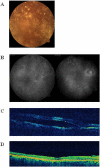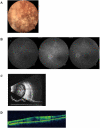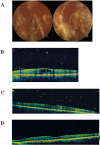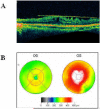Optical coherence tomography in asteroid hyalosis
- PMID: 16829809
- PMCID: PMC2771563
- DOI: 10.1097/01.iae.0000224502.33905.66
Optical coherence tomography in asteroid hyalosis
Abstract
Purpose: To demonstrate the clinical utility of optical coherence tomography (OCT) in diagnosing macular structural abnormalities in patients with asteroid hyalosis.
Methods: Case series.
Results: Seven eyes of seven patients underwent OCT due to inadequate funduscopic visualization secondary to asteroid hyalosis. Fluorescein angiography and B-scan ultrasonography were conducted for two patients but failed to provide diagnostic clarity. OCT provided definitive anatomical diagnoses that included macular epiretinal membrane, macular hole, traction retinal detachment, cystoid macular edema, and drusen. On the basis of OCT-assisted diagnoses, three patients elected to undergo surgical intervention.
Conclusion: OCT can be critical to diagnose macular conditions when retinal visualization is limited by asteroid hyalosis.
Figures






References
-
- Fawzi AA, Vo B, Kriwanek R, Ramkumar HL, et al. Asteroid hyalosis in an autopsy population: The University of California at Los Angeles (UCLA) experience. Arch Ophthalmol. 2005;123:486–90. - PubMed
-
- Hampton GR, Nelsen PT, Hay PB. Viewing through the asteroids. Ophthalmology. 1981;88:669–72. - PubMed
-
- Feist RM, Morris RE, Witherspoon CD, et al. Vitrectomy in asteroid hyalosis. Retina. 1990;10:173–7. - PubMed
-
- Ikeda T, Sawa H, Koizumi K, et al. Vitrectomy for proliferative diabetic retinopathy with asteroid hyalosis. Retina. 1998;18:410–4. - PubMed
-
- Parnes RE, Zakov ZN, Novak MA, Rice TA. Vitrectomy in patients with decreased visual acuity secondary to asteroid hyalosis. Am J Ophthalmol. 1998;125:703–4. - PubMed

